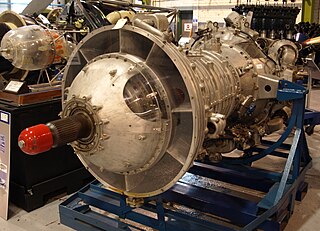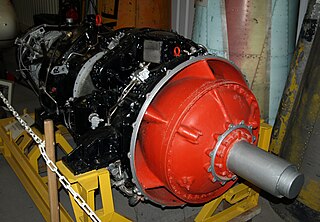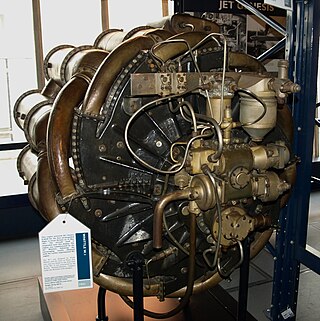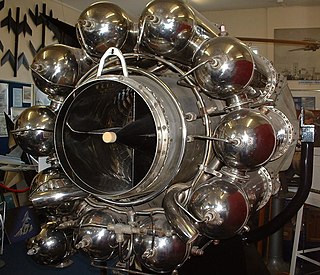
A turboprop is a gas turbine engine that drives an aircraft propeller.

The Rolls-Royce RB.53 Dart is a turboprop engine designed and manufactured by Rolls-Royce Limited. First run in 1946, it powered the Vickers Viscount on its maiden flight in 1948. A flight on July 29 of that year, which carried 14 paying passengers between Northolt and Paris–Le Bourget Airport in a Dart-powered Viscount, was the first regularly scheduled airline flight by a turbine-powered aircraft. The Viscount was the first turboprop-powered aircraft to enter airline service - British European Airways (BEA) in 1953.

The Rolls-Royce RB.41 Nene is a 1940s British centrifugal compressor turbojet engine. The Nene was a complete redesign, rather than a scaled-up Rolls-Royce Derwent, with a design target of 5,000 lbf (22 kN), making it the most powerful engine of its era. First run in 1944, it was Rolls-Royce's third jet engine to enter production, and first ran less than 6 months from the start of design. It was named after the River Nene in keeping with the company's tradition of naming its jet engines after rivers.

The Armstrong Siddeley Mamba was a British turboprop engine produced by Armstrong Siddeley in the late 1940s and 1950s, producing around 1,500 effective horsepower (1,100 kW).

The Rolls-Royce RB.37 Derwent is a 1940s British centrifugal compressor turbojet engine, the second Rolls-Royce jet engine to enter production. It was an improved version of the Rolls-Royce Welland, which itself was a renamed version of Frank Whittle's Power Jets W.2B. Rolls-Royce inherited the Derwent design from Rover when they took over their jet engine development in 1943.

The Rolls-Royce RB.23 Welland was Britain's first production jet engine. It entered production in 1943 for the Gloster Meteor. The name Welland is taken from the River Welland, in keeping with the Rolls-Royce policy of naming early jet engines after rivers based on the idea of continuous flow, air through the engine and water in a river.

The Rolls-Royce RB.39 Clyde was Rolls-Royce's first purpose-designed turboprop engine and the first turboprop engine to pass its civil and military type-tests.

The Bristol Orion aero engine is a two-shaft turboprop intended for use in later marks of the Bristol Britannia and the Canadair CL-44. Although the engine was built and underwent a development program, the BE.25 Orion project was cancelled in 1958 by the British Ministry of Supply in favour of the Rolls-Royce Tyne. In addition, interest in turboprop-powered aircraft was beginning to wane, because of the successful introduction of the Boeing 707 and Douglas DC-8 jetliners into airline service.

The Rolls-Royce RB.401 was a British two-spool business jet engine which Rolls-Royce started to develop in the mid-1970s as a replacement for the Viper. RB.401-06 prototype engines were already being manufactured when a decision to develop the higher thrust RB.401-07 was taken.

The Rolls-Royce Gem is a turboshaft engine developed specifically for the Westland Lynx helicopter in the 1970s. The design started off at de Havilland Engine division and passed to Bristol Siddeley as the BS.360. Rolls-Royce bought out Bristol Siddeley in 1966 and after it dropped the Bristol Siddeley identity the engine became the RS.360.

The Armstrong Siddeley Python was an early British turboprop engine designed and built by the Armstrong Siddeley company in the mid-1940s. Its main use was in the Westland Wyvern, a carrier-based heavy fighter. The prototypes had used the Rolls-Royce Eagle piston engine, but Pythons were used in production aircraft. In this application, the Python was rated at 4,110 equivalent shaft horsepower (eshp).

The Rolls-Royce RB.93 Soar, also given the Ministry of Supply designation RSr., was a small, expendable British axial-flow turbojet intended for cruise missile use and built by Rolls-Royce Limited in the 1950s and 1960s. Like all the company's gas turbine engines it was named after a British river, in this case, the River Soar.

The Napier Eland is a British turboshaft or turboprop gas-turbine engine built by Napier & Son in the early 1950s. Production of the Eland ceased in 1961 when the Napier company was taken over by Rolls-Royce.

Power Jets was a British company set up by Frank Whittle for the purpose of designing and manufacturing jet engines. The company was nationalised in 1944, and evolved into the National Gas Turbine Establishment.

The Rolls-Royce RB.162 is a lightweight British turbojet engine produced by Rolls-Royce Limited. Developed in the early 1960s, it was specially designed for use as a lift engine for VTOL aircraft but was also used in a later variant of the Hawker Siddeley Trident airliner as an auxiliary boost engine. A smaller related variant, the RB.181 remained a design project only, as did a turbofan version designated RB.175.

The General Electric T31 was the first turboprop engine designed and built in the United States.

The Rolls-Royce/MAN Turbo RB.193 is a vectored thrust turbofan engine designed and manufactured by Rolls-Royce and MAN Turbo in the mid-1960s. The engine test flew in its sole application, the VFW VAK 191B VTOL fighter aircraft but production did not follow after cancellation of the associated aircraft project.

The Power Jets W.2 was a British turbojet engine designed by Frank Whittle and Power Jets Ltd. Like the earlier Power Jets W.1, the reverse-flow combustion configuration included a double-sided centrifugal compressor, 10 combustion chambers and an axial-flow turbine with air-cooled disc. It entered production as the Rolls-Royce Welland and was the first UK jet engine to power operational aircraft, the Gloster Meteor.

The Rolls-Royce RB.145 was a British jet engine designed in the early-1960s by Rolls-Royce for use as a lightweight VTOL lift and cruise engine. Developed from the Rolls-Royce RB108 the RB.145 featured more accessories and a higher thrust rating. Six engines developed by MAN Turbo were fitted to the first prototype of the EWR VJ 101 experimental German fighter aircraft, achieving supersonic flight by July 1964.

The Rolls-Royce RB.203 Trent was a British medium-bypass turbofan engine of around 10,000lb thrust designed for production in the late 1960s, bearing no relation to the earlier Rolls-Royce RB.50 Trent turboprop or the later high-bypass Rolls-Royce Trent turbofan.





















